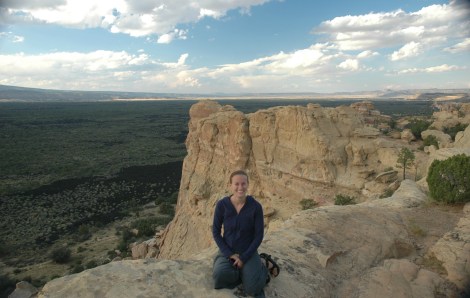
Sanders Moore.
Imagine looking out over your city and instead of seeing a sea of brown and grey rooftops, you’re looking at reflective black, all the way to the horizon.
That’s the view Sanders Moore is trying to bring to Albuquerque. Moore is the 31-year-old state director at Environment New Mexico, an advocacy group (and part of the Environment America network) that works to get citizens to demand better environmental policy from their elected leaders. “Our goal is to get 100,000 roofs covered in solar panels by 2020,” she explains.
Here’s how a woman from Atlanta landed in the high, Southwestern desert with dreams of getting an entire state off oil and powered by the sun.
Q. What brings an urban, southern belle to the Land of Enchantment?
A. I would say that I’ve cared about the environment as long as I can remember. There was the Save the Whales campaign in the ’80s — that really tugged on my 8-year-old heartstrings — “I want to save all the whales in the ocean.” When I got to college, I majored in political science. I didn’t realize until then how interested I was in the political process and policy and how it impacts our lives. Then I wanted to connect those two things [environmentalism and politics].
Q. So that explains your greenie bent, but why the Wild West?
A. For a pretty big part of my life, I remember always wanting to move west. After I graduated from college, I wanted to move, but it didn’t work out at that point. Then to further my career, I got a master’s in environmental law. I wouldn’t say I had my eyes set on one particular place, [but] given the opportunity for a career here, it seemed to fit perfectly — big open skies, and the green chile doesn’t hurt.
Q. And how are you saving the whales, so to speak, in New Mexico?
A. New Mexico is the second sunniest state in the country but we only get 2 percent of our energy from the sun. I don’t think it needs to be that way. I think we have the ability to really repower our state. At the state level, we want policies [that encourage] more solar development. We’re also working with cities to pass resolutions for encouraging residents to put solar panels on their houses. We’re talking to thousands of New Mexicans about the issue.
We’re also trying to get the Rio Grande del Norte and Otero Mesa designated as national monuments. [Otero Mesa, in the far southern reaches of the state] is about the state’s last untapped water source, but unfortunately it is open to natural gas [drilling] and hard-rock mining.
Q. You’re talking a lot of process, less chaining yourself to trees. What’s your angle on environmental wins?
A. I personally think the best way to attack these issues is to engage the public and get them to weigh in with the political process. Between 2011 and 2012 we talked to about 50,000 New Mexicans, getting a lot of widespread support [to ban drilling in the Otero Mesa.] Fortunately, people here care about water — we have a very limited amount of it. People don’t want to see New Mexico being destroyed for short-term gain.
Q. OK, but these are federal lands you’re trying to protect — why should someone in New York care about drilling in a desert thousands of miles away?
A. Beyond the precedent that it sets for doing the same thing in New York, if that drilling or mining impacts the water supply, I think down the road, that’s going to impact everything. When I first started trying to get a job in the environmental field, someone asked me what my biggest environmental concern was and they wanted me to pick: “Air? Water? Land?” I think that so much of it’s just connected.
Q. Let’s talk bottom line — what’s the impact to New Mexico’s famous (and ridiculously delicious) green chile if the state doesn’t get off oil and onto sun power?
A. Climate change is one of the biggest issues facing us today — a lot of that comes from our dirty energy sources, like coal and oil. There’s definitely a connection: We’re experiencing a major drought [in New Mexico] and that’s affecting the chile crop — it’s affecting all agriculture in the state.
[Editor’s note: Don’t believe her? A study by New Mexico State University found that chile farming using drought techniques impacted the flavor of at least one of the state’s famous varietals.]




